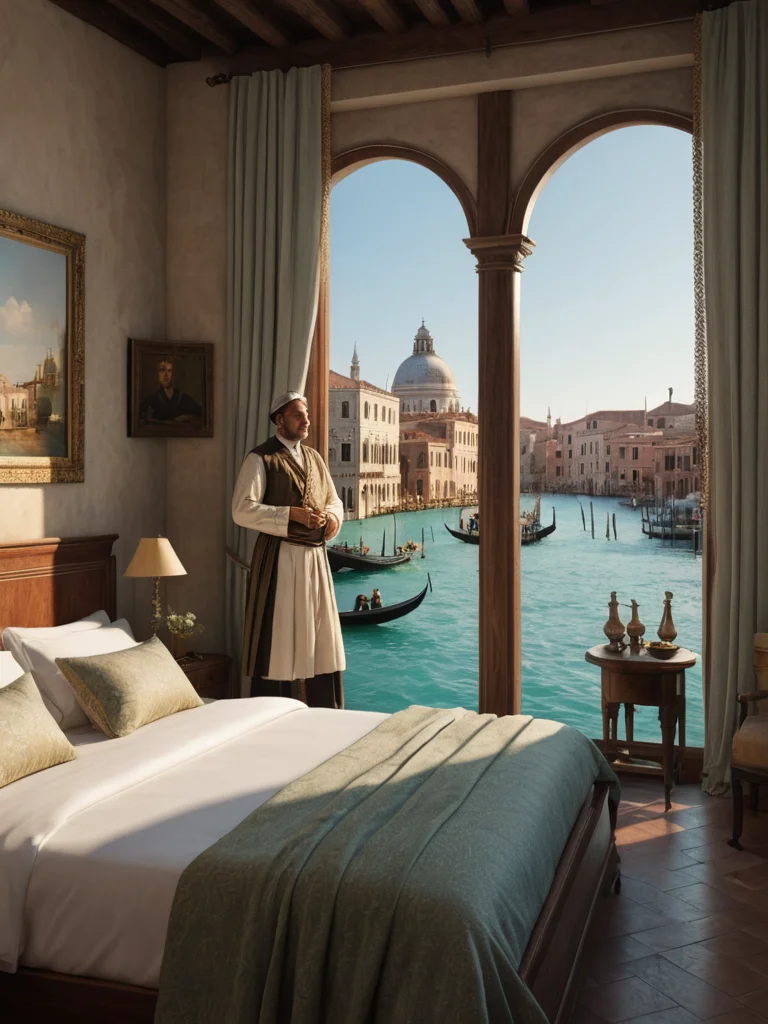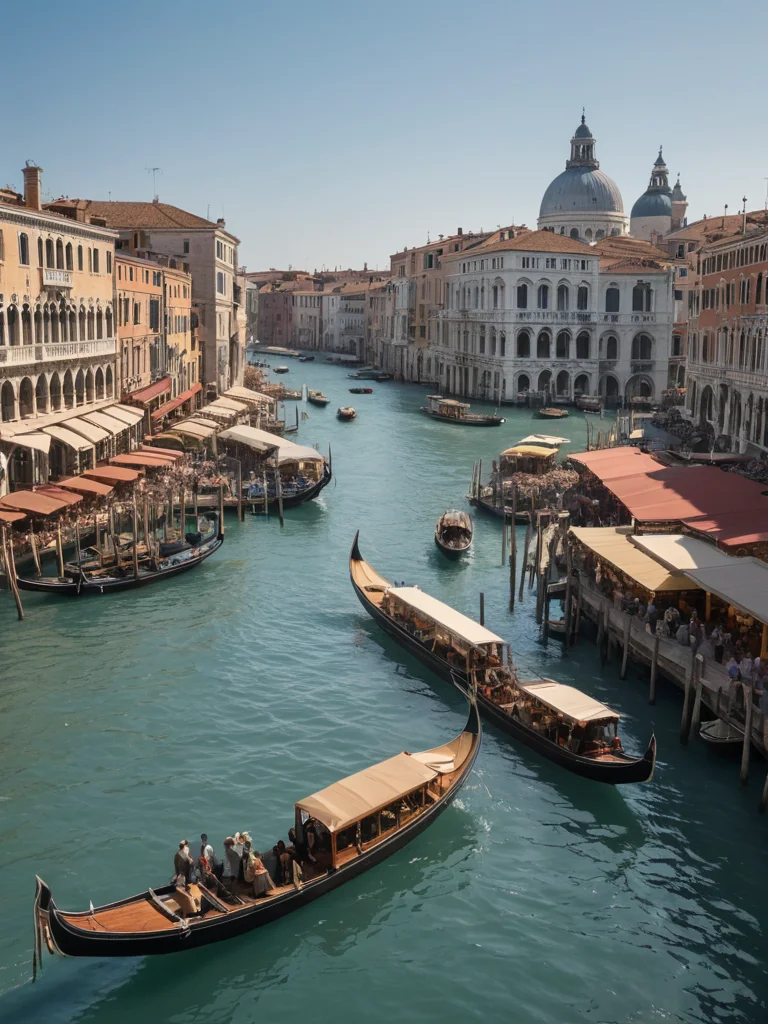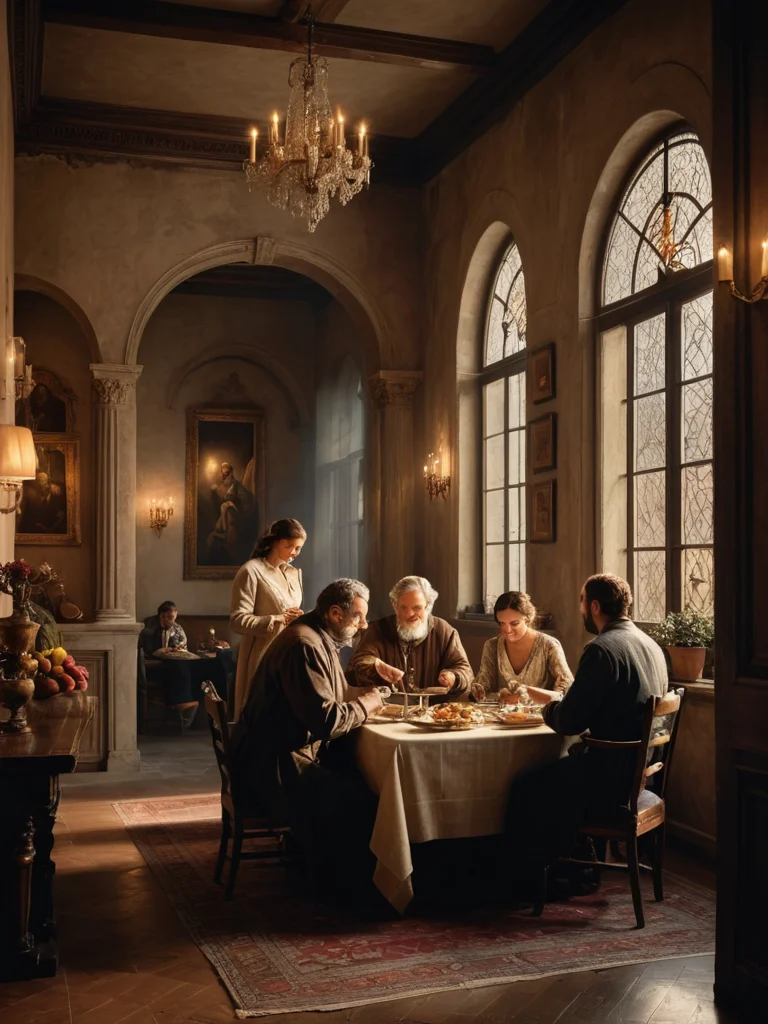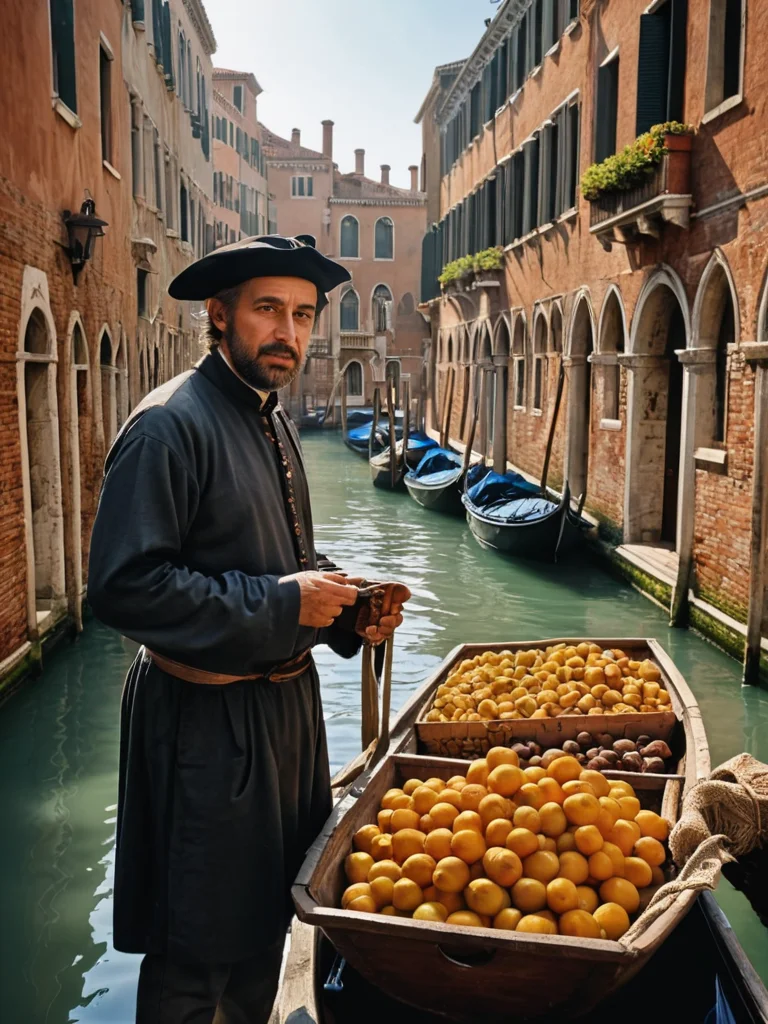Welcome to Venice, the pearl of the Adriatic, a city that for centuries served as a bridge between East and West, a center of unprecedented wealth and cultural exchange. Imagine the scene: the lagoon shrouded in a misty haze, the sun rising on the horizon, illuminating the spires of cathedrals and red tiled roofs. In this setting unfolded the lives of Venetian merchants – people who not only traded but literally shaped the global economy of their time. Their daily concerns, risks, and triumphs were inextricably linked to the rhythm of the city, the splash of the canals, and the whisper of the wind bringing news from distant lands. Today, we will delve into one such ordinary, yet incredibly eventful day, to understand what it was like to be the heart of a thriving trading empire.
First Rays Over the Lagoon: Secrets of a Merchant’s Morning Rise
Early morning in 14th-16th century Venice. The city was still asleep, enveloped in pre-dawn silence, broken only occasionally by the cries of seagulls or the gentle lapping of water against the foundations of houses. For a Venetian merchant, especially one who headed a large trading company, every hour, every minute counted. Therefore, as historians note, his day began long before the sun’s rays fully dispersed the darkness. The alarm clock was not a mechanical watch – they were expensive and not always accurate – but rather a habit, an internal rhythm tuned to the relentless pace of business life. The first sounds that penetrated the bedroom through the barred windows of the palazzo could have been the bells of a nearby church calling to morning mass, or the distant voices of the first gondoliers already preparing for their workday.
Waking up was usually early, before dawn. The merchant, a middle-aged man, often with streaks of gray at his temples from constant worries and tense deals, would rise from a massive four-poster bed. His bedroom, though part of a large, richly furnished house, was functional. The clothes he wore at home were comfortable, yet dignified enough to reflect his status. It could be a robe made of expensive fabric brought from the East, or a loose linen shirt. Hygiene practices in those times were far more modest than today, but nevertheless, the merchant paid attention to neatness, as his appearance was an important part of his business image.
After a brief morning ablution, a mandatory breakfast followed. It was usually light and nutritious: bread, perhaps cheese, some fruit if the season allowed, and water or diluted wine. Breakfast was often taken with the family, if they were in Venice. This was the little time the merchant could calmly interact with his wife and children before plunging into the whirlpool of business meetings. However, even at the table, his thoughts were already occupied with the upcoming affairs. He might give instructions to the servants, briefly discuss pressing matters with the household manager, or review letters that had arrived before dawn.
Spiritual life played a huge role in the life of a medieval person. Venetian merchants were no exception. The morning often began with prayer. Many had small chapels in their homes where they could offer their supplications. Or, if time permitted, they would attend morning mass at a nearby parish church. Believers of that time sincerely believed that success in business depended not only on their own wit and diligence but also on the blessing of Heaven. It was not just a ritual, but a deep need of the soul, giving strength and confidence in the face of numerous risks that trade entailed.
Having completed his morning rituals, the merchant would proceed to a preliminary review of his affairs. In his study, or “scrinium” as the place for working with papers was then called, the first reports, new letters delivered by night ships or couriers, awaited him. He might quickly review the income and expenditure books, check the status of accounts entrusted to local bankers or money changers, and, most importantly, assess the latest news from trade routes. What was the situation in Alexandria? What was new from Flanders? What were the prices of pepper in Genoa? These questions shaped his plan for the day. He would give his first orders to his clerks, secretaries, and servants, preparing them for the tasks ahead. By the time the sun rose over the domes of St. Mark’s, the Venetian merchant was fully ready to fight for his place under that sun, for the prosperity of his family and his republic.
The Pulse of the City: How Business Hours Unfolded on the Rialto and in the Docks

Leaving his palazzo, the Venetian merchant would head to the very heart of business Venice – the Rialto district. The path could lead through narrow calle, past awakening bakeries and artisan shops, or along the waterways if the merchant had his own gondola or hired a gondolier. Every intersection, every bridge was already bustling with life: porters with loads, vendors calling out their wares, foreign merchants speaking dozens of languages – all creating a unique atmosphere of continuous movement and lively trade. The Grand Canal, the city’s main artery, was at this time filled with all sorts of vessels: from small sandoli carrying vegetables to huge merchant galleys just returned from distant voyages.
Upon arriving at the Rialto, the merchant would immerse himself in the epicenter of the commercial world. Here, by the famous Rialto Bridge, was one of Europe’s largest markets. But the Rialto was not just a place for retail trade; it was also a financial center, an exchange, and a place for closing major deals. Here, one could hear Turkish, Arabic, German, French, and English spoken, mixed with the characteristic Venetian dialect. Merchants from different countries, dressed in their national costumes, bustled between the stalls, exchanging news, rumors, and, of course, goods.
The merchant’s primary place of activity was likely his office or representative office on the Rialto, often located in one of the numerous buildings such as the Fondaco dei Tedeschi (German warehouse) or similar structures for merchants of other nationalities, which served simultaneously as a warehouse, hotel, and trade representation. Here, in his own study, or directly in the bustling square, the most important negotiations took place. The Venetian merchant was a master of diplomacy and bargaining. He had to understand not only prices and quality of goods but also people’s psychology, the intricacies of international law, and the ever-changing political situation.
Business hours on the Rialto were extremely intense. The merchant could conduct several negotiations simultaneously, delegating some of them to his experienced clerks. He would examine spice samples, feel expensive silks, weigh precious metals. He needed deep knowledge of the origin of goods, their quality, possible defects, and, of course, market value. Merchants of that time were true experts in their niches, capable of distinguishing a fake from an original and assessing goods “by eye.”
Special attention was paid to financial operations. Venice was a pioneer in the development of many banking instruments. Here, one could exchange money of various countries, obtain or issue a bill of exchange, and arrange a loan against future goods delivery. The merchant worked closely with money changers (banchieri), who sat at their tables (banchi, hence “bank”) and conducted operations with coins. The importance of reputation was colossal: one unfulfilled obligation could ruin a merchant’s career, depriving him of trust and the ability to conduct business. That is why many deals were concluded not only on the basis of written contracts but also on the basis of verbal agreements, sealed with a handshake.
In addition to the Rialto, the merchant regularly visited the docks and shipyards of the Arsenal. It was there that he could oversee the loading and unloading of goods, check the condition of his ships or the vessels carrying his cargo. Routes, delivery times, and security issues were discussed. Piracy was a constant threat in the Mediterranean, so many large shipments were sent as part of convoys protected by the Republic’s warships. The merchant had to be aware of all maritime affairs, know the captains, and assess their reliability and experience, as the safety of his investments depended on it.
Lunchtime was short and functional. Often, the merchant would have lunch in his office or at a nearby tavern if it allowed for continued business negotiations. Lunch typically consisted of simple but hearty dishes: vegetables, fish or meat, bread, and wine. For the Venetian merchant, immersed in business, the luxury of the table was less important than the efficiency of time.
Behind the Scenes of Wealth: Family, Leisure, and the Invisible Risks of Trade

Behind the splendor of Venetian palazzi and the bustle of the Rialto lay a complex and strictly organized family life, which for the Venetian merchant was no less important than his business activities. The home was not just a refuge but also a symbol of status, a center of social and economic life. The Venetian family was patriarchal. The head of the family – the merchant – made all key decisions concerning both business and household members. However, his wife played a crucial role in managing the household. She supervised the numerous servants, organized daily life, handled the upbringing of children, and represented the family’s interests in his absence. Often, the merchants’ wives themselves came from noble or wealthy families, which strengthened their social position and gave them access to important connections.
Children, especially sons, were involved in family affairs from an early age. For them, there was no concept of “school holidays” in the modern sense. Education was strictly practical. Sons were taught literacy (reading, writing), arithmetic (skills in working with large numbers and various currencies were especially important), geography (knowledge of trade routes was critical), and foreign languages. Latin was the language of science and the church, but for trade, Greek, Arabic, German, and French were no less important. It was believed that the best university for a future merchant was practice. Therefore, boys spent time in their father’s office from an early age, observing his work, copying documents, and familiarizing themselves with business ethics and customs. As teenagers, they might embark on long voyages as assistants or even representatives of their father to study markets firsthand and establish necessary connections. Daughters were taught household management, etiquette, and how to run a large home, as their future lay in a favorable marriage, which was often part of a strategic alliance between two influential merchant families.
Leisure time for Venetian merchants, though limited by a tight schedule, still existed. It was not idle in the modern sense. Merchants, being educated and curious people, valued intellectual pursuits. They might be fond of reading – religious texts, chronicles, ancient authors, as well as books on navigation and astronomy, geography, which were directly related to their profession. Many were patrons: they supported artists, sculptors, architects, and musicians, thus contributing to the cultural prosperity of Venice and immortalizing their names. Participation in church and secular processions, attending city festivals, and membership in “scuole” – religious or charitable brotherhoods – were also an important part of their social life, strengthening their social connections and influence.
However, behind all this ostentatious luxury and order lay immense risks that the merchant faced daily. Maritime trade was an extremely dangerous business. The main threats were piracy and storms. Pirates, whether Ottoman, Barbary, or European, constantly plundered merchant ships, seizing goods and enslaving crews. Storms could destroy an entire fleet in an instant, sending not only cargo but also the lives of sailors to the bottom. It is no wonder that every sea voyage was accompanied by prayers and blessings. In addition to direct maritime threats, there were also economic risks: price fluctuations, changes in demand, partner bankruptcies, currency devaluation, political instability, wars that could block trade routes. The plague and other epidemics were also a constant threat, capable of paralyzing trade and devastating cities.
To minimize these risks, Venetian merchants developed complex and innovative mechanisms. One of the key principles was diversification: they rarely invested all their funds in one commodity or one route. Instead, they spread their investments across various cargoes, ships, and destinations so that losses from one failure would not be catastrophic for the entire enterprise. Partnerships such as “commenda” or “colleganza” were widely used, where one partner provided capital, and the other provided labor and experience, sharing risks and profits. Venice was also one of the first places where forms of marine insurance developed, where for a certain fee, a merchant could insure his cargo against loss, significantly reducing financial risks. All these measures, combined with unprecedented business acumen and a network of informants throughout the Mediterranean, allowed Venetian merchants to cope with challenges and maintain their dominance in international trade for many centuries.
Sunset Over the Canal: Evening Reflections and the Great Legacy of Merchants

As the sun began to set, painting the lagoon waters in golden-crimson hues, the rhythm of business Venice gradually slowed. However, for the merchant, the day was not yet over. Returning home – perhaps in his gondola, slowly gliding through the darkening canals, or on foot through torch-lit streets – he did not cease to think about business. This journey home was a time for final reflections on the day’s events, assessing successes and failures, and forming plans for tomorrow. Perhaps at this moment, he was already considering new strategies or deciding how to respond to a recent letter from Constantinople.
Upon arriving at his palazzo, the merchant did not immediately indulge in rest. Often, the evening was dedicated to working with papers. He might personally review the accounting books kept by his clerks to ensure the accuracy of the entries, reconcile accounts, and calculate profits for the day or week. Maintaining accurate accounting was the cornerstone of a successful business. Every income and expense, every transaction, every debt and credit had to be meticulously recorded. Many merchants themselves wrote letters to their agents and partners, dictating them or drafting them for their secretaries. Correspondence was vital for maintaining an extensive trade network, and these letters often contained not only business instructions but also valuable information about political events, commodity prices in other cities, and even personal news.
The evening dinner was more substantial than the morning or midday meal. It was a time when the whole family gathered, sharing the day’s news. The table was richly set, especially if there were guests. Venetian merchants loved to display their wealth, and a generous table with delicacies brought from all corners of the world was the best proof of this. These could include Eastern spices, rare fruits, exotic wines. Such dinners often turned into small social events where not only family matters were discussed, but also politics, culture, rumors, and gossip from the world of trade.
After dinner, the merchant might devote time to his leisure. This could be reading in his library, which housed manuscripts and books on a wide range of subjects – from philosophy to geography. Some merchants were fond of music, collecting rare instruments or inviting musicians. Others preferred quiet games, such as chess. Religious rites were also part of the evening, perhaps family prayer or attending evening service. For many merchants, this was a time for solitude, for reflecting on their lives, their place in the world, and their responsibility before God and family. They saw themselves as part of something greater than just personal well-being – they were the pillars on which the prosperity of the entire Republic rested.
Before going to sleep, the merchant would mentally run through all the points of his plan for the next day, considering the details of future deals, potential risks, and strategies for minimizing them. Sleep was short but necessary to regain strength for another intense day. The life of a Venetian merchant was full of difficulties and challenges, but it was precisely thanks to their perseverance, ingenuity, and fearlessness that Venice became one of the greatest maritime powers in history. Their daily routine, their business practices, and their pursuit of new horizons shaped not only the economic power of the city but also laid the foundations of the modern financial system and international trade relations. The legacy of these brave traders still lives on in the elegant palazzi, in every paving stone, in every corner of this unique city, where the echo of their voices still whispers of great deeds and untold riches.
